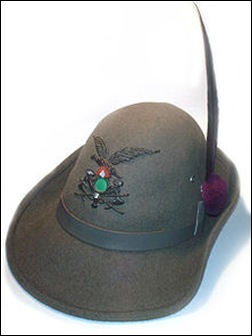The scope of the Alpini’s duties goes far beyond their involvement in war, as they are always ready to deal with emergencies such as earthquakes, floods or landslides. In 1873, shortly after they were formed, they promptly helped the population of Alpago, near Belluno in Northern Italy, which was hit by an earthquake. More recently they have been actively involved in UN and NATO peace keeping operations, such as the war in the Balkans and in Afghanistan.
L’Associazione Nazionale Alpini (National Alpine Association) has more than 34000 members throughout Italy. Within the Association there are groups of Donatori di Sangue (blood donors), squadre di soccorso alpino (mountain rescue teams), and gruppi specializzati nel restauro di chiesette, rifugi alpini, monumenti, strade di montagna, ecc. (groups who specialize in the restoration of chapels, mountain refuges, monuments, and mountain roads, etc.)
The uniform
The original Alpini uniform was typical of the military uniforms of the 19th century: white trousers and blue jacket. Certainly not very suitable attire for hiding in the mountains, so in July 1905 a battalion experimented with a new grey-green uniform in order to improve their camouflage. In 1908, following the success of the experiment, the whole of the Italian army adopted this color for their uniforms.
The most distinctive part of the Alpini uniform is the hat: il cappello degli Alpini, which is considered a sacred symbol by every Alpino. The hat is shaped like a cupola with a pointed peak. On the left side there is a feather, 25-30 cm long, inclined slightly backward. The type of feather used depends on the rank of the soldier: a black raven feather for the troops, a brown eagle feather for non-commissioned officer and lower grades officers, and a white goose feather for upper grade officer and generals.

Equipment
When the Alpini were first founded, each company was provided with one mule and a cart in order to transport provisions and materials. In 1888 the mule quota was increased to 8 per company. These tireless hard working animals, perfectly adapted to the alpine terrain on which the Alpini operated, were finally retired in 1991 (not the original ones of course!).


Another important innovation in the equipment of the Alpini was their use of skis: in November 1902, after a trial period the Alpini were given this new and fast mezzo di trasporto (means of transport), which solved the problem of moving quickly on snow!
This is, of course, just a very brief history of the Alpini. If you are interested you can find more about the Alpini here: http://en.wikipedia.org/wiki/Alpini


Comments:
Vince Mooney:
Salve Serena:
Prego dicami l’uso di Alpini piume artificiali dell’aquila!!!
Vincenzo
Natalia De Luca:
Why are woman and non registered military people allowed to join an alpini regiment, some are even of another race? I disagree with this vehemently. They have even been given a sacred hat to wear. None of these people were ever in the military and are a discrase to that group. Can they be outed?
serena:
@Natalia De Luca Salve Natalia, in reply to your question, see my new blog ‘A Controversial Question’, which will be published on the 30th of September.
Serena
onelia bardin:
my father was in the 4th regiment degli alpini during the second war please can you tell me where i can find a number 4 which was on his capello as he no longer has the original.
serena:
@onelia bardin Salve Onelia, I really can’t help you there I’m afraid. Do you speak Italian? You could try starting with the website of the Associazione Nazionale Alpini : http://www.ana.it/
If you get stuck let me know.
Saluti da Serena